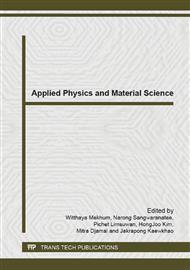p.366
p.370
p.374
p.378
p.382
p.386
p.390
p.395
p.401
Eco-Friendly Dyeing of Cotton Fabric Using Ultrasonic Energy with Natural Colorants Extracted from Mulberry Leaves
Abstract:
The dyeing of cotton fabrics using mulberry leaves (Morus alba L.) as a natural dye has been studied in both conventional heating and ultrasonic techniques. The extractability of Mulberry leaves dye from natural origin using power ultrasonic was also evaluated in comparison with conventional heating. The mulberry leaves extract to provided brown-green to green color, depending on the pH concentration. The results of dye extraction indicate that power ultrasonic is rather effective than conventional heating at low temperature and short time. The effects of dye bath pH, dyeing time, dyeing temperature and mordants were studied and the colorimetric parameters L*, a*, b* of dyed fabrics with ultrasonic and conventional techniques were compared.
Info:
Periodical:
Pages:
382-385
Citation:
Online since:
June 2014
Authors:
Keywords:
Permissions:
Share:
Citation:


